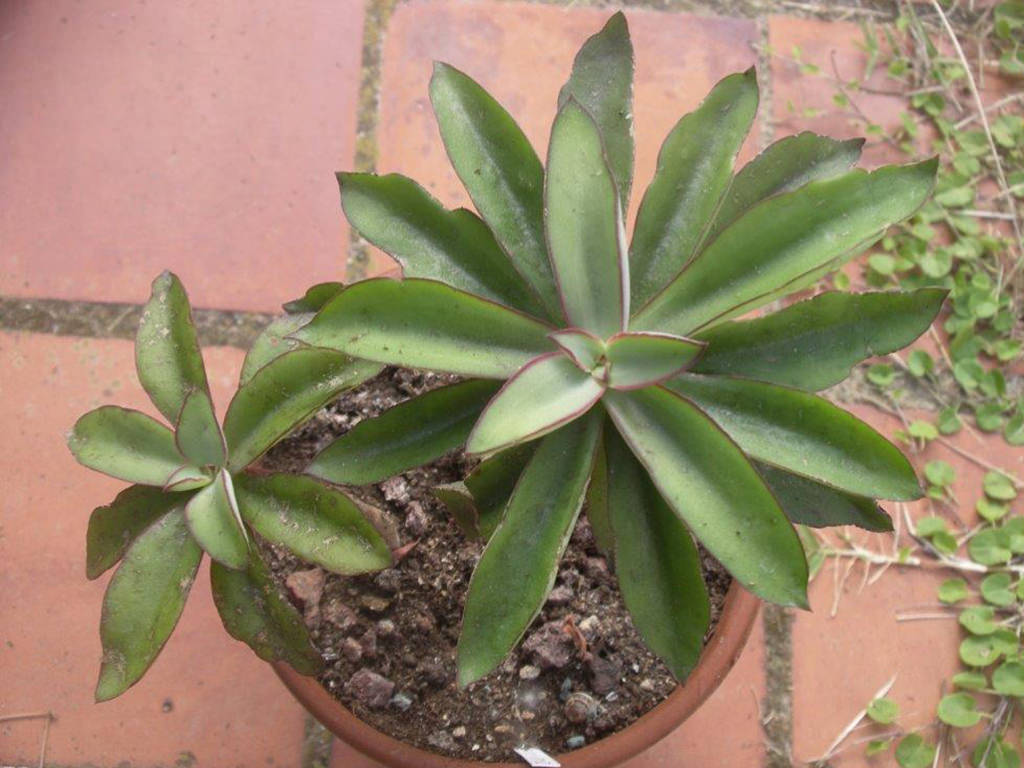Scientific Name
Echeveria penduliflora Walther
Scientific Classification
Family: Crassulaceae
Subfamily: Sempervivoideae
Tribe: Sedeae
Genus: Echeveria
Origin
This species is native to Mexico (Oaxaca).
Description
Echeveria penduliflora is a succulent plant that forms few-leaved rosettes at the tips of an erect, usually unbranched stem. It grows up to 1 foot (30 cm) long, producing offsets at the base to form a small shrub. The rosettes grow up to 4.8 inches (12 cm) in diameter. Leaves are thick, fleshy, and green to lavender gray with brown margins. They are obovate to oblanceolate, up to 11.6 inches (14 cm) long and up to 1.6 inches (4 cm) wide. Flowers are salmon pink, bell-shaped, up to 0.5 inches (1.3 cm) long, and appear in clusters on erect, up to 1 foot (30 cm) long stalks in summer.
Etymology
The specific epithet "penduliflora (pend-yoo-lee-FLOR-uh)" is a feminine form of the New Latin adjective "penduliflorus," meaning "having hanging flowers," and refers to the pendulous nature of the flowers.

How to Grow and Care for Echeveria penduliflora
Light: E. penduliflora prefers full sun to partial shade. If you are moving your plant outside in the spring, do it gradually. The intense afternoon sun can cause sunburn. When your E. penduliflora is inside during the winter, put it near the brightest window in your home. It will stretch if it does not have enough sunlight.
Soil: This succulent needs a potting soil mix that drains quickly. Many growers will create their own mix. However, commercial succulent potting mixes will work fine.
Hardiness: This plant is a tender succulent, which means it must be brought indoors for the winter to survive. E. penduliflora can withstand temperatures as low as 20 to 50 °F (-6.7 to 10 °C), USDA hardiness zones 9a to 11b.
Watering: Provide moderate amounts of water from spring to fall. The "soak and dry" method is the preferred schedule for watering E. penduliflora. If you have saucers under the pots, make sure after a short time to empty the water. During the winter months, water just enough to keep the plants from shriveling.
Fertilizing: E. penduliflora grows well without fertilizer but may benefit from the extra nutrients. Use a slow-release fertilizer in spring or a liquid fertilizer diluted 2 to 4 times more than usual and used less often than recommended.
Repotting: Repot the plant only as needed during spring or early summer when it is actively growing. To repot your E. penduliflora, ensure the soil is dry before repotting.
Propagation: Like all Echeverias, this succulent is usually propagated from leaves and offsets, but it can also be grown from stem cuttings and seeds. Spring is the best time to take cuttings and separate offsets. Sow the seeds in spring or summer.
Learn more at How to Grow and Care for Echeveria.
Toxicity of Echeveria penduliflora
E. penduliflora has no toxic effects reported. It is safe around pets and humans, although it is not advisable to eat it.
Links
- Back to genus Echeveria
- Succupedia: Browse succulents by Scientific Name, Common Name, Genus, Family, USDA Hardiness Zone, Origin, or cacti by Genus
Photo Gallery
Click on a photo to see a larger version.



